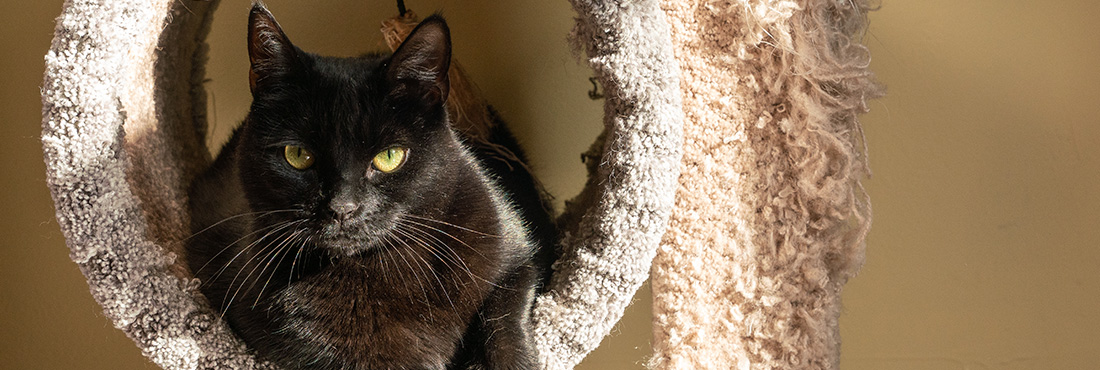The medical term for dehydration is ‘hypohydration’ and it describes a serious and potentially life-threatening situation. Put simply, dehydration arises when an excessive amount of water and electrolytes (that’s minerals such as sodium, chloride, and potassium) are lost from your cat’s body.
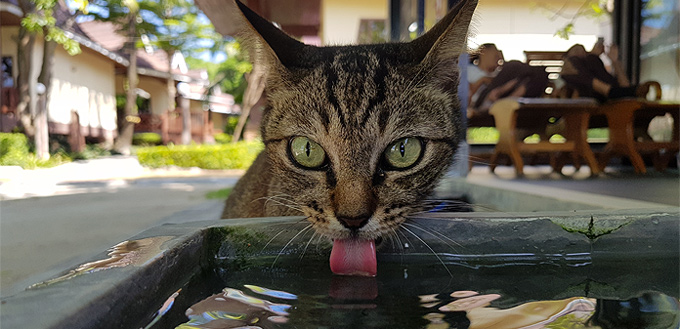
Cats are like most mammals in that they are made up of at least 60% water. Dehydration can be chronic (not so serious but goes on for a long time) or acute which is very serious and requires immediate intervention. Young kittens, older moggies, and cats with other medical conditions are at an increased risk from dehydration.
The Symptoms of Dehydration in Cats
There are some visual and behavioural symptoms of dehydration in cats but there are also tests that can be carried out to diagnose dehydration.
A dehydrated cat will have the following symptoms:
- Eyes – will appear sullen, drowsy or sunken and ‘dull’
- Lethargy – appears lazy, sleepy and does not interact or play with you
- Heart rate – higher heart rate than normal
- Panting – cats rarely pant so breathing fast with their mouth open signals overheating and dehydration
- Gums – will feel dry and tacky instead of moist
- Not drinking – you may have observed that they are not drinking water or conversely, they may be taking on unusually large quantities of water
- Constipation – this is because their body will be trying to conserve water by reabsorbing it from the feces (poop) as it passes through the colon
- Infrequent urination – check how often they are visiting the litter box
- Loss of appetite – your cat refuses to eat
If you are an experienced cat owner or breeder, you may wish to carry out some further tests for dehydration at home. On the other hand, you may feel more comfortable seeking advice from a veterinary clinic.
The first test for dehydration is the skin turgor test which you may see referred to as ‘skin tenting’. To do this, you firmly hold the skin at the scruff of their neck and gently pull it out and up to form a tent shape. The skin should spring back into place immediately. If it retracts slowly, it indicates that your puss is dehydrated. If the skin remains in a tent shape and does not retract at all, it indicates that they are severely dehydrated and you need to get them to a vet straight away.
The second is called the capillary refill test. It is used to assess your cat’s circulation and therefore indicates either dehydration, heart failure or shock. You need to lift your cat’s upper lip and press firmly with the flat of your finger against their gum for a few seconds. When you remove your finger, it will initially leave a white mark. Time how long it takes for the white mark to turn back to pink. In a healthy cat, it will take one or two seconds. If it takes two to four seconds, it is a cause for concern. However, if it takes more than four seconds it is an emergency. It is important to note that if it takes less than one second it is also an emergency.
Vets can do further tests to confirm the cause of the dehydration including blood tests, urine analysis and tests of kidney and liver function and tests for diabetes.
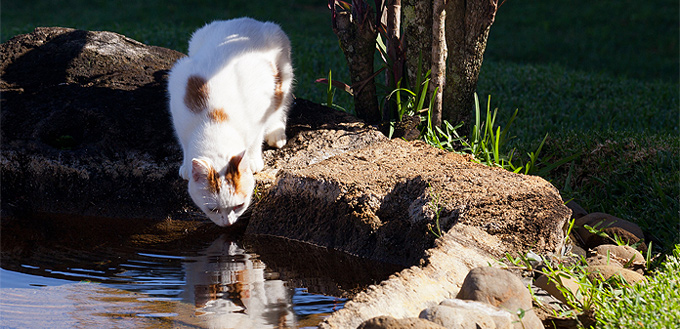
Risk Factors for Dehydration in Cats
Dehydration is not good for cats. Even if a medical emergency is not triggered, long-term it can result in kidney problems because there is insufficient water to flush out toxins. There are some risk factors that make the chances of your cat becoming dehydrated higher. These are the main risk factors for dehydration in cats.
- Diarrhoea and vomiting
Diarrhoea and/or vomiting for more than a day inevitably causes dehydration. When your cat has diarrhoea, they have a lot of very watery poop and they will lose a lot of fluids. It reaches a point where it becomes impossible for them to replace the fluid just by drinking water.
In practice, this means that a cat that has had diarrhoea for more than two/three days will need special fluids obtained from a vet.
- Medical conditions
There are several other medical issues that trigger dehydration. If your cat has increased urination or drooling they will be losing a lot of water. This places them at increased risk. Dehydration is also associated with urinary tract obstruction and heatstroke. These always need to be checked out by a vet.
- Dried food
Cats on a dried food diet are at an increased risk of dehydration. An average dried food diet only provides around 40 ml of water but a cat needs at least 200 ml every day so they have to drink at least 160 ml which is an awful lot of water. Very few cats will do that! Cats that are also fussy drinkers will get nowhere near that volume.
The problem is that cats have evolved from desert animals and in the past, they would have taken on most of their water from eating prey (small rodents) – which are moist. As a result, cats are not programmed to drink a lot and they struggle to compensate for a dried food diet. Switching to a moist food diet will reduce the risk.
Related Post: Best Wet Cat Food
- Diabetes and kidney failure
Both diabetes and kidney (renal) failure cause a cat to urinate excessively so they end up losing a lot of fluid. It is hard work to try to make sure that they replace it. You may consider getting food for diabetic cats or food for cats with kidney problems.
Dehydration Treatments
The treatment of dehydration is a specialist medical skill and only a vet is qualified to carry it out. The aim is to replace fluids and electrolytes and to diagnose and treat the cause of the dehydration. Your vet will administer intravenous (into a vein) or subcutaneous (under the skin) fluids and then run some tests to determine the underlying cause of the loss of fluids. Water alone may not be sufficient at this stage. Your puss may need a balanced electrolyte solution. This is because dehydration is not just about a loss of water. It is also a problem with the electrolyte balance of the body. This needs to be rectified so that their body will be able to absorb water again.
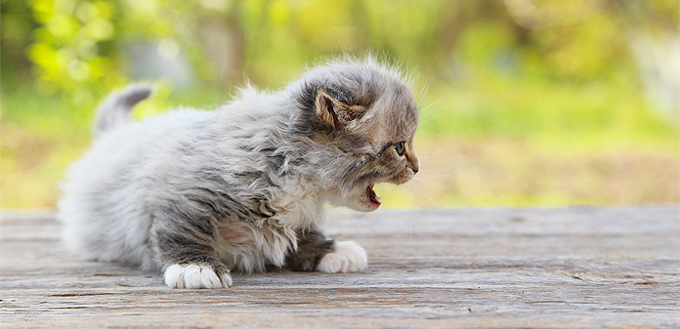
It may be necessary to give your puss some medication to stop them from being sick or to help the diarrhoea and this will stop them losing so much fluid.
You may be asked to continue the rehydration treatment at home. You will be given needles, syringes, and special fluids. It is important to note that this is NOT simply water and this should only be attempted under the guidance and direction of a vet. You will be shown how to lift up the loose skin at the back of the neck and insert the needle under the skin before slowly pressing the plunger into the syringe.
Preventing Dehydration in Cats
As a general rule, an adult cat needs the same amount of water (in millilitres) as the number of kilocalories they eat in a day. You can get this information from cat food labels. As your kitten grows, they will need more calories and therefore more water. Not all cats do that and some are chronically dehydrated.
Diet is also important. Dried cat food contains only around 10% water whereas canned (and pouched) food can be up to 80% water. Obviously, cats on a diet of dried food will need to consume a lot more water! If you are concerned that your cat is not drinking enough it may be better to switch to canned or raw food.
You should monitor your cat’s water intake. If you calculate that they are not drinking enough water, it is time for a trip to the vet. If there is an obvious cause for an episode of dehydration, such as a bout of diarrhoea and vomiting, you may be able to get some fluids in your poorly puss by giving them an ice cube to lick and then providing small quantities of water.
Encouraging a Cat to Drink
Cats can be extraordinarily fussy drinkers and you will need to find ways to encourage them to take on enough water to keep them healthy.
- The water must be clean
You need to provide clean water at all times but this will often not be enough. You will have to change it frequently to keep it fresh and clean out the bowl thoroughly to prevent bacterial build-up.
- Bowls must be in the correct position
You may need to place bowls all over the house and always site them away from food bowls and litter boxes and anything else that may potentially frighten your cat when they are drinking.
- The right type of water and bowl
Some cats prefer tap water but for others, it has to be distilled water or even mineral. You can test this by filling several identical bowls with different types of water and observing which one they prefer.
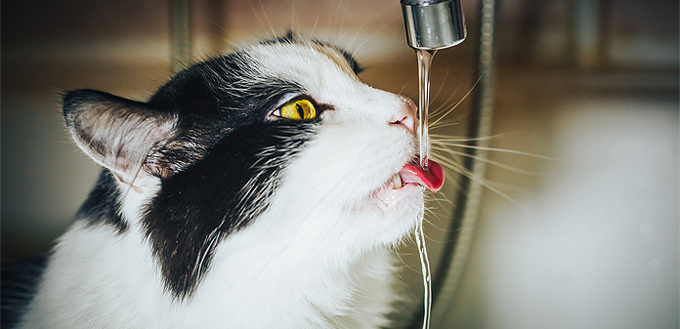
The type of feline water bowl is also crucial. Plastic bowls are rarely successful because they are porous and absorb odours. This is enough to put cats off. Stainless steel or ceramic bowls are a better option. In terms of shape, the drinking bowl needs to be wide enough to fit your cat’s whole face and that includes their whiskers. They like to look around them whilst they are having a drink!
- Multiple cats need multiple bowls
Cats do not like sharing bowls. You must have one bowl for each of your cats.
- Adding flavour to the water
Some owners have successfully used a food additive to entice their pets to the water bowl. You can add a flavour in the form of chicken broth or tuna juice to the water bowl. It will need to be changed regularly to avoid bacterial build-up. You could also sprinkle some extra water on their food.
- Adding ice-cubes to water bowls
Bowls of warm water are never going to entice a fussy moggy to drink. If you are going to be out for a while, keep their water nice and cool for several hours by popping in a few ice-cubes.
You could even make special tuna or chicken flavoured ice-cubes by adding some water from a can of tuna or chicken broth. As they melt, the odour will attract your cat over to the water bowl. Make sure you label them clearly in the freezer though so no humans put them in their drinks!
- Water fountains are a better option
Bowls of water may simply not be working for your puss! Whilst it is true that cats hate being immersed in a body of water, they are fascinated by running water and prefer to drink from a stream of running water than from a bowl. In the wild, they would drink from streams where the water is fresh and cool. They may perceive a bowl of water as stagnant and therefore unsafe.
This is why cat water fountains are so successful. The water is constantly circulated through filters and purifiers and is even aerated. This keeps it fresh and free from impurities so it always smells and tastes fresh. It also remains cool and cats can be spotted checking how cold the water is with their paws. Cool, running water from a fountain will be more attractive to them than still, warm water in a bowl. If you have several cats, they will be happy to share a water fountain but will not be willing to share a bowl!
With some care, innovation, and imagination it is possible to reduce the risks of dehydration in your cat and help them to live a healthy life.
Sources:
- P. A. Doris, Effects Of Dehydration On Thermoregulation In Cats Exposed To High Ambient Temperatures, American Physiological Society
- Naomi Millburn, Severely Dehydrated Cats, The Nest
- Cat Dehydration: Symptoms, Causes, and Treatments, WebMD
Note: The advice provided in this post is intended for informational purposes and does not constitute medical advice regarding pets. For an accurate diagnosis of your pet's condition, please make an appointment with your vet.



